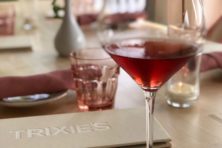WINE:30 – Rosé
- Share
- Tweet
- Pin
- Share
Rosé is considered to possibly be the oldest known type of wine. Traveling from what is now known as Turkey, the Phocaeans were believed to have brought along pink hued wine on their search for new trade routes. They ended up in Marseille and so began the growth of the wine industry in France.
This pale colored, pink wine they made came from the simple process of growing the grapes, harvesting them, crushing the juice out and letting that juice ferment. Not until later did wine producers begin the process of keeping the juice in contact with the skins for longer periods of time to make darker, more intense wines.
Today, pink wines are made from three main processes: the process above of leaving the juice in contact with the skins and seeds for a limited period of time (one to three days); the saignée method; and, very rarely, by mixing red and white wine together. The most popular of the three would be the first and oldest method.
The saignée method incorporates taking the some of the pale pink juice from the first press of a red grape and fermenting it separately from the rest of the juice remaining with the skins and seeds. This allows the remaining juice to become darker and more affected by the tannins in the skins and seeds.
Rosé had taken a step back in popularity until the sweet pink version of blush wines such as white zinfandel became a big seller to sweet wine drinkers over the last several decades. And while there is still a larger variety of sweet pink wines, such as white zinfandel, white merlot, pink Moscato and a variety of box blush wines, the off-dry to bone dry rosés of old are making an inspired comeback.
Over the last several years, stores and restaurants have begun to offer less sweet, more serious wines in the pink hue family. From Provence to Oregon and everywhere in between, rosé is being produced more prominently and being well received.
These days you will see blush wines made from Pinot Noir to Malbec to just about any combination of well-known French varietal around, including extremely well crafted sparkling wines. These wines will also have a spectrum of different hues, progressing from light pink, rose petal, coral, cotton candy, cherry red, ruby to raspberry.
So, if you are looking for a different summer patio beverage, take a closer look at the dry rosé. There are more and more being stocked on grocery store shelves and are available at most restaurants by the glass these days. They are a great option for a glass by itself as well as a great food accompaniment!
Karl Bradley is the wine sales representative for General Beverage Wines for the Door County area. He has worked in fine dining and wine sales for more than 25 years and has a sommelier certificate from the Court of the Master Sommeliers.


